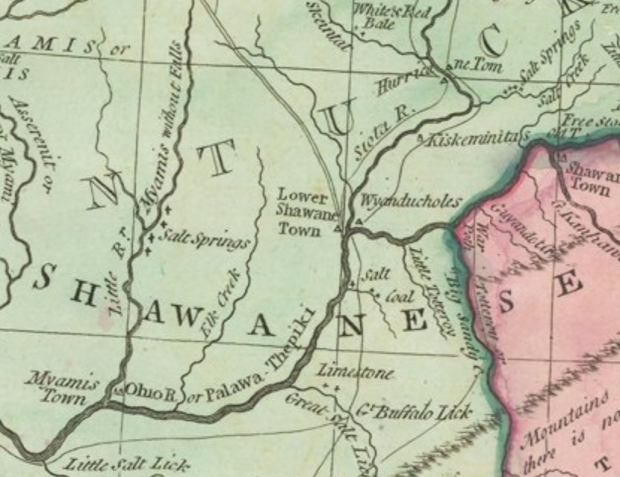I’m looking right now at the Ohio River, that great and beautiful stream whose name is said to mean just that, in poetry and on place mats. But has anyone heard that explanation and seriously believed it? Perhaps many Ohioans do believe it, and that is why we have the state legislature that we do.
As is typical of American place names claimed to come from native languages, the story of the name Ohio is a fish tale, so to speak. The state name came from the river, of course. But there has not been scholarly agreement on what the name is supposed to mean, though there is consensus that it comes from Seneca language. The Seneca have long lived nowhere near the Ohio River, and once occupied the Ohio Valley for only a short time, as invaders, so this is reason for suspicion off the bat.
History.com, OhioRiverTrail.org, the National Park Service, and the Ohio History Connection all assert wrongly that Oyo is an Iroquois word for “great river,” and all without citation. Wikipedia says Ohiyo is Seneca for “good river” or “great river.” The Bureau of Indian Affairs says it is Iroquois for “beautiful river.” This trend, which represents precious little cogitation about the name, kowtows to tourism-promotion interests, who want the name of the river made pretty, since the days when it was called “the Bloody River” because of the genocide by firearms that occurred along its shores. The whitewash etymologies have been copied innumerable times.
Even the American Indian Studies Program at OSU has jumped on the pseudo-etymology bandwagon: “Ohio comes from the Seneca (Iroquoian) ohiiyo’ ‘good river’ to refer to both the Allegheny and Ohio Rivers because they are linked by canoe portages.” This makes no sense at all; the Allegheny is continuous with the Ohio. No portage is necessary, and there is no reason to think that ohiiyo means “good river” in any language. This is etymology by conspiratorial laziness. Denial seems to be a river in Ohio.
It’s time to sort things out.
None of these etymologies has a basis in genuine Seneca language or any other Iroquoian language. The Seneca, who had seized the river from the Shawnee using guns provided by the Dutch of New Amsterdam, did refer to the river as something akin to Oyo or Oho, rendered by the French explorer Celeron as “Oyo” in 1749, but that cannot mean great or good or beautiful river in Seneca. According to Wallace Chafe’s English-Seneca Dictionary, the suffix for beautiful is -iyo but the words for river and water are gehode and onega respectively. The Seneca stem for big or great is gowa, which appears in no version of the Ohio name. A Seneca individual may have called the river big or beautiful, but they were not saying its name. The -iyo suffix has no documentation that it was ever really there, and was probably added to Oyo in order to force the name to look like it means something beautiful. Oy vey.
The meaning “beautiful river” obviously comes from the French name for the Ohio, which was “La Belle Riviere,” as dubbed by La Salle in 1669, when the river was still in Shawnee hands and the Seneca were not involved except as imperial interlopers. That appellation was La Salle’s personal opinion and there is nothing native about it. Both LaSalle and Celeron, by the way, buried lead plates along the river, in order to lay imperial claim to the valley as French territory. To accept their name for the river is as anti-indigenous as accepting Columbus as the name of the state capital.
Similarly, the meaning “great river” is the literal meaning of Mississippi, of which the Ohio was considered by many Algonquians to be the main branch. Thus, to call the Ohio “great river” was a western Algonquian thing, not Iroquoian. How likely would it be that Algonquian Mississippi and Iroquoian Ohio would have exactly the same literal meaning while the Algonquians were at war with the Iroquois? Academe has been remiss in not noting the contradiction.
That huge error can be located precisely. Writing in the Quarterly of the Ohio Archaeological and Historical Society in 1920, William E. Connelley of Kansas realized that the French explanations of the name were mistaken – the same explanations still given as authoritative. Connelley then attempted to find the real meaning of Ohio through conversations with Wyandot informants in the early 20th century. This is problematic because 20th century Wyandots could not be expected to know the meaning of a 17th century Seneca name, especially since the Wyandots had been allies of the Shawnee against the Iroquois of the Five Nations in New York.
Sure enough, the Wyandots gave Connelley an interpretation of the name based on the Algonquian perspective of the Ohio being part of the Mississippi River system, with “the Great River” extending from Pittsburgh to New Orleans. Connelley wrote: “All the Iroquois called it the Great river. It ran from their western possessions to the gulf—the sea. They considered it the main stream. With them it was the Ohio to the Gulf of Mexico.”
The list of Iroquoian names he gave was as follows: “In Wyandot it is O-he-zhu. In the Mohawk and Cayuga it is O-he-yō. In the Oneida it is Ohe. In the Seneca it is the same as in the Wyandot.” Connelley is the source on which all of the modern etymologies are based, but they seldom cite him, because his essay included such obvious errors.
What Connelley failed to realize was that the meaning “Great River” was borrowed from the Algonquians as a translation of Mississippi, while the Iroquoian cognate list is attached to a different meaning entirely. This should have been clear because the Seneca and the other four Iroquois nations of New York didn’t travel to the Gulf of Mexico. Their range of movement along the Ohio was always blocked by their Shawnee enemies. (Today these nations have great relations, but historically, as Francis Parkman wrote at great length, the Shawnee-Iroquois enmity formed the political backbone of North American history.)
Adding to the confusion, the Seneca, confined to a reservation in upstate New York in the 20th century and beginning to lose knowledge of their language, heard from so many white sources that their name for the Ohio means great or beautiful river, they themselves began to believe it, and so that meaning of “Ohiyo” or “Oyo” back-migrated into modern Seneca, despite its incorrectness.
Such a name violates Native American convention. With the exception of the Mississippi, which merits the exception, Native Americans named rivers and other geographical features by distinctive traits, not general platitudes. For example, the name Scioto clearly does come from the Iroquoian word ohskënonton, which means deer in Mohawk and Wyandot languages. The Scioto Valley was and is a principal hunting ground for deer.
We might ask, then, what Oyo or Ohiyo really did mean in Seneca language, and fortuitously, the answer is pretty obvious. The Seneca word for owl is o’owa, and great horned owl is ohi-ih. In Mohawk it is ó:ha. Iroquoian owl words are onomatopoetic from the sound of an owl, with the specific sounds variable over time and place, as in Algonquian languages. However, Iroquoian linguist Marianne Mithun postulates that the o- prefix denotes natural as opposed to man-made objects, so the name of the Ohio likely is a noun denoting a natural object, not some generalized adjective like beautiful or great.
Cherokee, a southern Iroquoian language, calls each kind of owl by a word resembling its hoot: wahuhi is screech owl; uguku is barred owl. The Shawnee word for owl is kookohoo. These names are cognate to English owl and hoot.
Perhaps most importantly, the general Cree word for owl, related to the Shawnee, is ôhô (oohoo), ôhow, or óhowak. Eastern Cree had a strong influence on Iroquoian language and is likely the basis for the Seneca word for owl, ohi-ih, and the Mohawk word for owl, ohowa. Even Ohioans today, in the south, say the name as if it is an owl hoot or a yawn: Oohaaoo.
If we compare these owl words with Connelley’s list of Iroquoian names for the Ohio River – Ohe, Oheyo, Ohezhu – it becomes apparent that the Iroquois were calling it the Owl River, before the meaning was imperialized and beautified by the French. That name makes sense. Owls were associated with death for both the Iroquois and Algonquians, and with the soul-catching spirit of the wendigo.
Indeed, the word wendigo is thought to derive from wintekOWA, a word originally meaning owl. During the Beaver Wars, the Ohio was truly a river of death, known in Colonial times as “the River of Blood.” We can imagine that the owl hoots along the river were taken to be the cries of the departing souls, and that the death taboo surrounding owls was a reason that the Iroquois were reluctant to tell that meaning to Europeans. Perhaps the Seneca even saw themselves as the wendigos that would snatch so many souls along the river and send them to their afterlife. Ohio was the heart of it all, indeed.
Try selling that one to the Convention and Visitors Bureau.
Now we can reconstruct what happened. The Seneca and Wyandots, who were the principal Iroquois nations to travel the Ohio, called it the Owl River in their languages, a name close to Oohoo, which Celeron heard as Oyo. The French were disinterested in what the name meant in native language, and attached it to their own “La Belle Riviere.” Since “beautiful river” was implausibly French-sounding, later writers including Connelley, attached the Algonquian meaning of the Ohio-Mississippi system name, which was “great river.” Note that the supposed corruption of Oyo to Ohio was actually a correction, as Ohio is closer to the original name that meant owl. Since 1920, the tourism-promoters and historical societies have shunned the task of fact-checking and have rested on Connelley, despite his fairly-obvious mistakes.
Speaking of imperialism, why are we even fixated on the Seneca name, which is not indigenous to the Ohio Valley? Before Europeans equipped the Iroquois with firearms, precisely to enable them to wage a proxy war against the Shawnee, the middle Ohio Valley, extending in both directions, was firmly Shawnee, and had been Shawnee for about 3,000 years, back to the arrival of the Adena, who were Shawnee ancestors.
The long delay in European penetration of the Ohio Valley until the latter part of the 17th century was precisely due to its control by the very-defensive Shawnee. Early French maps of the Ohio Valley mark the unexplored part “Chouanon” – the French rendering of the Shawnee name. The valley remained Shawnee until it was wrested from them by gun-toting Iroquois in the so-called Beaver Wars, which brought a slaughter of the yet-unarmed Shawnee unremembered only because it was unrecorded by Euro-Americans. Even though the Shawnee returned in the 18th century to take back their homeland, after acquiring firearms, they were betrayed by the new American government, which “purchased” the valley from the Iroquois, even though the Iroquois no longer even occupied it.
For a true indigenous name of the river, we must look to what the Algonquians called it. Here, there are a variety of choices. As previously mentioned, western Algonquians considered the Ohio to be part of the Mississippi, and so referred to it by that name, which does, in fact, mean great river. It is sure that many other Algonquian tribes simply called the Ohio proper the Shawnee River, using the form for Shawnee as existed in their particular language. Ironically, this name stuck for two rivers in the south where the Shawnee had sojourned during the Beaver Wars: the Suwanee River and the Savannah River.
There then is a long list of mistaken names for the Ohio River coming from white confusion. Native guides would often warn of whitewater on the river, especially near the famous Falls of the Ohio, and whites often took the word for “whitewater” or “whitecaps” as the river’s name. This name stuck for the Wabash River, the name of which comes from the Algonquian word for whitewater. We shall probably never know what the actual name of that river was. The novelist Alan Eckert, who was notoriously bad at alerting his readers to his imaginative fictions, listed six Algonquian-sounding names for the Ohio River, all of which are as bullshitty as a Herschel Walker lecture on foreign policy.
As for what the Shawnee themselves called the river, we are lucky that the answer is unambiguous and well-documented. David Jones, a Welsh Baptist missionary, made two trips to the middle Ohio River in 1772 and 1773, memorialized in his famous journal. There he reported that the Shawnee call the river “Pellewaa Theepee” or “Turky River.” That is confirmed by the Laurie & Whittle edition of Lewis Evans’s landmark map of the Middle British Colonies, published from the surveys of Evans, Thomas Walker, and Christopher Gist, 1750-51. That map calls it “Ohio R. or Palawa Thepiki” (see map portion, centered on where the Scioto meets the Ohio). Palawa is well-attested as the Shawnee word for turkey, from the Proto-Algonquian word for bird. The Evans map was used by the British officers who prosecuted the French and Indian War.
That the middle Ohio River was called Turkey River by the Shawnee eliminates the possibility that the lower and upper Ohio were each called “great river” by other native nations. “Great river” has been the filler so that historical societies and government agencies do not have to admit ignorance or confess that they have proffered imperialist lingo in place of something genuinely native.
So, the real indigenous name of the river is Palawa Thipi, Turkey River, or, loosely, River of Turkeys. It’s a prophetic name. I’ve been asked to write a regular column for Columbus Free Press, and have decided to call it River of Turkeys. It will focus on Ohio politics, obviously.
Thanks to Cindy Manzi of Chillicothe for research help.
______________________________________
Geoffrey Sea is a historian and writer living in Portsmouth, Ohio. He is the administrator of the Adena Core group on Facebook.




